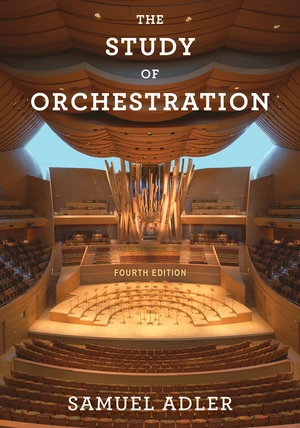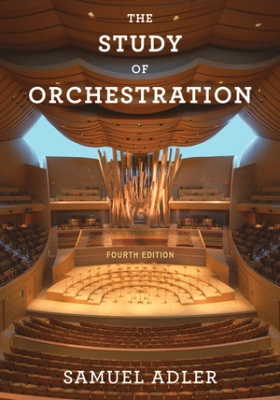Opens in a new window
W.W. Norton & Co. Inc The Study of Orchestration (Fourth Edition) - Adler - Book/Media Online

- Composer/Author: ADLER, SAMUEL
- Instrumentation: TEXT
- Model # 9780393600520
Format: Book with Audio and Video Online
Subject: Orchestration Text
The book that set the standard for orchestration texts.
Written by a renowned composer whose works have been performed by major orchestras around the world, The Study of Orchestration is the only text that explores the characteristics of orchestral instruments and shows students how a master composer approaches orchestration. The Fourth Edition invites students to experience the instruments through online audio and video recordings and now offers more coverage of writing for band. Access to the recordings is included with every new copy.
The only text that invites students to listen
The Study of Orchestration is accompanied by comprehensive audio and video recordings -- featuring musicians at the Eastman School of Music -- illuminating the techniques students encounter in the text. Access to the audio and video recordings is included with each new copy of the text at no additional cost, and access is good for 360 days.
The most comprehensive introduction to orchestral instruments and techniques
The Fourth Edition includes a masterful overview of every instrument and its techniques, a reference that students will use every time they arrange or compose. Every technique is illustrated with examples from the literature, and a groundbreaking audio and video package allows students to hear and see every instrument. This edition also offers updated coverage of percussion instruments and a new section on the accordion.
The only text that shows students how to write for band and orchestra
The Study of Orchestration is the only text that connects information about instruments to what students do as composers and arrangers. This new edition of the text and workbook offers additional coverage of music for wind ensemble. Orchestration in Action sections at the end of each chapter feature master composer and teacher Samuel Adler presenting his own compositions and demonstrating how to orchestrate.
Offers the best opportunities to practice orchestration
Robust media package provides students with an abundance of review and self-assessment opportunities. The Fourth Edition offers new and simpler assignments accessible to students with a range of skill levels. The workbook offers more than enough material for any orchestration class, so instructors can select the exercises that best suit their students' needs.
Contents:
- Part 1. Instrumentation
- 1. The Orchestra--Yesterday and Today
- 2. Bowed String Instruments
- Construction
- Tuning
- Fingering
- Double, Triple, and Quadruple Stops
- Divided Strings
- Vibrato
- Glissando and Portamento
- The Bow
- Bowing
- Special On-the-String Bowings
- Special Off-the-String Bowings
- Trills and Other Coloristic Effects Using the Bow
- Colouristic Effects without the Bow
- Mutes
- Scordatura
- Harmonics
- Contemporary String Techniques
- 3. Individual Bowed String Instruments
- Violin
- Viola
- Violoncello or Cello
- Double Bass
- 4. Plucked String Instruments
- Harp
- Guitar
- Mandolin
- Banjo
- Zither
- 5. Scoring for Strings
- Individuality within the Ensemble
- Foreground--Middleground--Background
- Contrapuntal Writing for Strings
- Homophonic Writing for Strings
- Using the String Choir to Accompany a Soloist
- Transcribing from Piano to Strings
- 6. The Woodwind Choir (Reed Aerophones)
- Construction
- Classifying Woodwind Instruments
- The Principle of Transposition
- Playing Techniques
- The Woodwind Section of a Symphony Orchestra
- Scoring for Woodwind Instruments
- 7. Individual Woodwinds
- Flute
- Piccolo
- Alto Flute
- Bass Flute
- Oboe
- English Horn
- Other Members of the Oboe Family
- Clarinet
- "Piccolo" Clarinet: Clarinet in D or E-flat
- Bass Clarinet
- Others Members of the Clarinet Family
- Saxophone
- Bassoon
- Contrabassoon
- 8. Scoring for Woodwinds and Woodwind-String Combinations
- The Role of Winds in the Symphony Orchestra
- The Variety of Orchestral Treatments
- Homophonic Writing for Winds
- Contrapuntal Writing for Winds
- Using the Wind Choir to Provide a Contrasting Color
- Using the Wind Choir to Double Other Instruments of the Orchestra
- New Types of Articulations For Woodwinds
- Special Effects
- Transcribing from Piano to Winds and Strings
- 9. Introduction to Brass Instruments
- Composition of the Brass Section
- Brass Instruments and the Written Orchestral Score
- Overblowing and the Principle of the Harmonic Series
- Crooks, Valves, and Slides
- Range
- Tone Production, Articulation, and Tonguing
- Common Characteristics and Effects on All Brass Instruments
- Mutes
- Muting Devices Other Than Mutes
- 10. Individual Brass Instruments
- Horn
- Trumpet
- Cornet
- Other Members of the Trumpet Family
- Trombone
- Other Members of the Trombone Family
- Tuba
- Other Members of the Tuba Family
- 11. Scoring for Brass, and Brass Combined with Strings and Winds
- Early Uses of the Brass Choir
- Doubling of Brass Instruments within the Modern Orchestra
- Homophonic Writing for the Brass Choir
- Using the Brass Choir to Present the Melody
- Contrapuntal Writing for the Brass Choir
- Climactic Uses of the Brass Choir
- Using the Brass Choir to Provide a Colouristic Effect
- 12. The Percussion Ensemble
- Historical Uses of Percussion Instruments within the Orchestra
- Number and Distribution of Percussion Players
- Notation of Percussion Instruments
- Mallets, Beaters, and Sticks
- Categories of Percussion Instruments
- Instruments of Definite Pitch
- Instruments Of Indefinite Pitch
- 13. Keyboard Instruments
- Piano
- Celesta
- Harpsichord
- Organ
- Harmonium
- 14. Scoring for Percussion with Keyboard Alone or in Combination
- Percussion Layout in the Full Score
- Percussion Section Setup
- Uses of the Percussion Section
- Part 2. Orchestration
- 15. Scoring for Orchestra
- The Unison-Octave Tutti
- The Distribution of Foreground--Middleground--Background Elements within the Orchestra
- Orchestrating a Melody or Primary Gesture
- Using the Orchestra to Create Special Effects
- 16. The Orchestra as Accompanist
- The Concerto
- Accompanying the Vocal Soloist, Ensemble, or Chorus
- 17. Transcribing for Orchestra
- Transcribing from Keyboard or Small Chamber Combinations to Orchestra
- Transcribing from Band or Wind Ensemble to Orchestra
- Transcribing to Various Available Instrumental Combinations
- 18. The Preparation of Score and Parts
- The Orchestral Score Setup
- The Reduced Score
- The Condensed Score
- Preparing Individual Parts
- 19. Scoring for Band or Wind Ensemble
- Scoring for Band
- Band Versus Wind Ensemble
- The Percussion Section within the Band or Wind Ensemble
- The Band and Wind Ensemble Score Setup
- Condensed Score
- Transcribing from Orchestra to Band or Wind Ensemble
- 15. Scoring for Orchestra
Q & A
There are currently no questions for this product.
Reviews
There are currently no reviews for this product. Be the first to write one!




